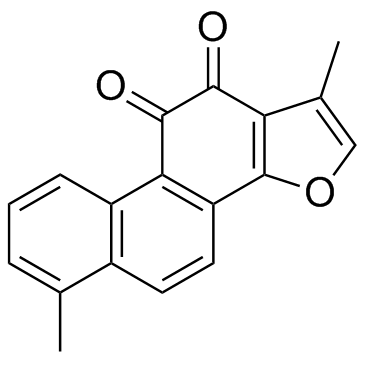Tanshinone I

Tanshinone I structure
|
Common Name | Tanshinone I | ||
|---|---|---|---|---|
| CAS Number | 568-73-0 | Molecular Weight | 276.286 | |
| Density | 1.3±0.1 g/cm3 | Boiling Point | 498.0±24.0 °C at 760 mmHg | |
| Molecular Formula | C18H12O3 | Melting Point | 233-234ºC | |
| MSDS | Chinese USA | Flash Point | 245.9±15.6 °C | |
|
Modulation of esterified drug metabolism by tanshinones from Salvia miltiorrhiza ("Danshen").
J. Nat. Prod. 76(1) , 36-44, (2013) The roots of Salvia miltiorrhiza ("Danshen") are used in traditional Chinese medicine for the treatment of numerous ailments including cardiovascular disease, hypertension, and ischemic stroke. Extracts of S. miltiorrhiza roots in the formulation "Compound Da... |
|
|
Tanshinone IIA inhibits viral oncogene expression leading to apoptosis and inhibition of cervical cancer.
Cancer Lett. 356(2 Pt B) , 536-46, (2015) Human papilloma virus (HPV) is the well-established etiological factor of cervical cancer. E6 and E7 oncoproteins expressed by HPV are known to inactivate tumor suppressor proteins p53 and pRb, respectively. Tanshinone IIA (Tan IIA) is a diterpenoid naphthoqu... |
|
|
Cloning, molecular characterization and functional analysis of 1-hydroxy-2-methyl-2-(E)-butenyl-4-diphosphate reductase (HDR) gene for diterpenoid tanshinone biosynthesis in Salvia miltiorrhiza Bge. f. alba.
Plant Physiol. Biochem. 70 , 21-32, (2013) The enzyme 1-hydroxy-2-methyl-2-(E)-butenyl-4-diphosphate reductase (HDR) is a terminal-acting enzyme in the plastid MEP pathway, which produce isoprenoid precursors. The full-length cDNA of HDR, designated SmHDR1 (Genbank Accession No. JX516088), was isolate... |
|
|
Phytoestrogen, tanshinone IIA diminishes collagen deposition and stimulates new elastogenesis in cultures of human cardiac fibroblasts
Exp. Cell Res. 323(1) , 189-97, (2014) It has been previously reported that oral or intra-peritoneal administration of tanshinone IIA can alleviate the ventricular hypertrophy and fibrosis that develops in rats after experimental cardiac infarction. Our present studies, performed on cultures of hu... |
|
|
Tanshinone IIA attenuates elastase-induced AAA in rats via inhibition of MyD88-dependent TLR-4 signaling.
VASA 43(1) , 39-46, (2014) The purpose of this study was to determine whether myeloid differentiation factor88-dependent Toll-Like Receptor-4 (TLR-4) signaling contributed to the inhibition of abdominal aortic aneurysm (AAA) by Tanshinone IIA (Tan IIA).Male Sprague-Dawley rats (n = 12 ... |
|
|
[Comparison of different preparation methods of tanshinoneporous silica solid dispersion].
Zhongguo Zhong Yao Za Zhi 38(19) , 3271-6, (2013) Porous silica was used as a carrier to prepare tanshinone solid dispersions (SDs). sThe effect of the spray drying method or the solvent method on the drug dissolution of SD was studied. The structure characteristics of SDs was analyzed by SEM, DSC,XPRD and F... |
|
|
Pharmacokinetics and atherosclerotic lesions targeting effects of tanshinone IIA discoidal and spherical biomimetic high density lipoproteins.
Biomaterials 34(1) , 306-19, (2013) High density lipoproteins (HDL) have been successfully reconstructed to deliver a large number of lipophilic drugs. Here, discoidal and spherical recombinant HDL loaded with cardiovascular drug tanshinone IIA (TA) were constructed (TA-d-rHDL and TA-s-rHDL), r... |
|
|
Synergistic combinations of tanshinone IIA and trans-resveratrol toward cisplatin-comparable cytotoxicity in HepG2 human hepatocellular carcinoma cells.
Anticancer Res. 34(10) , 5473-80, (2014) To determine the combinative effects of tanshinone IIA (Tan IIA) and trans-resveratrol (Resv) on cytotoxicity, apoptosis, cell-cycle arrest and DNA fragmentation in HepG2 human liver cancer cells.Cytotoxicity was detected by the cell proliferation and cytotox... |
|
|
Tanshinone IIA and Baicalin inhibiting the formation of benzo[a]pyrene and benzo[a]pyrene induced cytotoxicity: correlation with scavenging free radical.
Environ. Toxicol. Pharmacol. 36(2) , 403-10, (2013) Benzo[a]pyrene (BaP), a ubiquitous environmental pollutant, is formed by incomplete combustion of organic materials, and causes oxidative damage to cells and tissues due to reactive oxygen species (ROS). The purpose of this study is to investigate the inhibit... |
|
|
Neuroprotective effects of tanshinone IIA and/or tetramethylpyrazine in cerebral ischemic injury in vivo and in vitro.
Brain Res. 1488 , 81-91, (2012) The present study compared the potential neuroprotective effects of tanshinone (Tan) IIA monotherapy, tetramethylpyrazine (TMP) monotherapy, and Tan IIA+TMP combination therapy in adult rat subjected to cerebral ischemic injury using the permanent middle cere... |